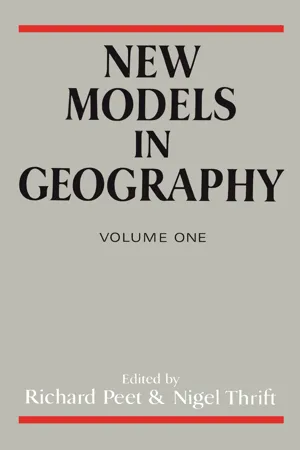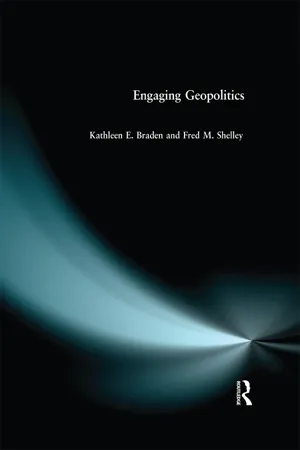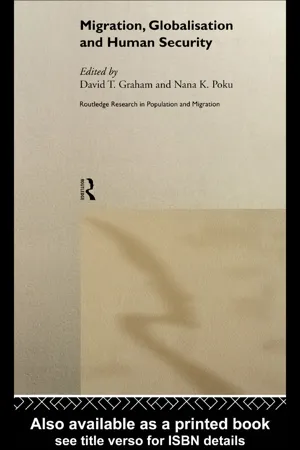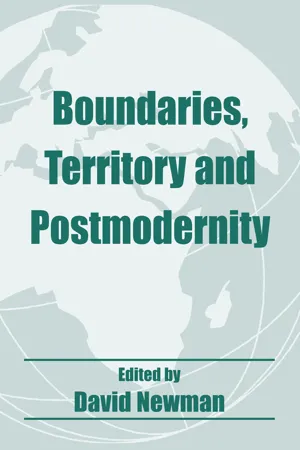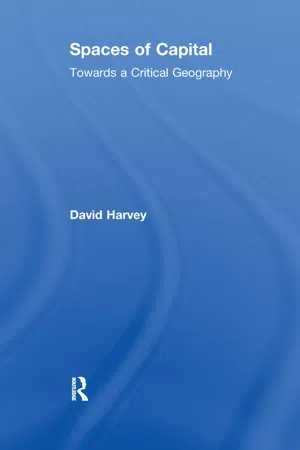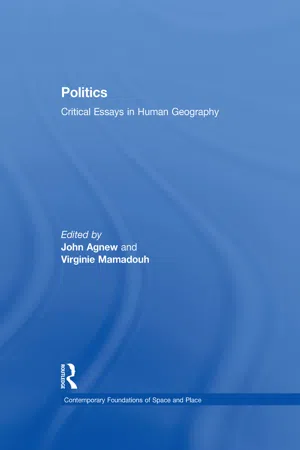Geography
Nation State Geography
Nation state geography refers to the study of the spatial organization and characteristics of a nation state, including its physical, cultural, and political features. It examines how the natural environment and human activities shape the boundaries, resources, and landscapes of a specific country. This field of geography also explores the interplay between a nation's identity, governance, and territorial space.
Written by Perlego with AI-assistance
Related key terms
10 Key excerpts on "Nation State Geography"
- eBook - ePub
- Richard Peet, Nigel Thrift(Authors)
- 2013(Publication Date)
- Routledge(Publisher)
The state, political geography, and geographyR. J. Johnston
A major component of the spatial organization of the Earth’s surface is its division into 150 or so sovereign states, each with a well defined (though perhaps contested) territorial reach. This division is commonly used in social sciences as a basic set of units of analysis – the world is described, and accounted for, in terms of similarities and differences among its states. That division is often accepted as unproblematic: it is natural to use countries as reporting units (despite some debate over whether countries are regions (Johnston 1984d)). The validity of this approach has rarely been questioned by political geographers, among whom the need for, and hence existence of, states has normally been taken for granted (Johnston 1980a, 1981a, 1981b). Further, the links between political geography and economic and social geography have rarely been explored, so that until recently the rôles of the state in everyday life, and the importance of state territory in that, have not been central geographical concerns.Attention has recently been directed towards the study of the state, however, and to incorporating political geography within the broader corpus of the discipline. In part this reflects the growth of the institution and apparatus of the state; it has been enlarged into a phenomenon that cannot be ignored in analyses of the contemporary scene (as many of the other chapters in this book indicate). There are studies not only of what the state does, but also of why: to understand state action, it is argued, we must understand why we have states.The issue of why we have states could be dismissed as of little relevance to the study of human geography. However, according to some arguments (e.g. Mann 1984, 1986) the state differs from other institutions because it is necessarily a territorial body - eBook - ePub
- Kathleen Braden, F.M. Shelley(Authors)
- 2014(Publication Date)
- Routledge(Publisher)
2Fundamental Concepts of Geopolitics
KEYWORDS
geography, nation, state, sovereignty, boundaries, territory, heartlandKEY PROPOSITIONS
• Geopolitics focuses on the geographical perspective of international relations.• The distinction between nation and state is crucial to understand and analyze many international conflicts.• There is a close relationship between power and territory at all geographic scales, sometimes leading to conflict over territorial control.• Geopolitics as a discipline has been influenced by British, French, German, American, and Russian theories.Geopolitics is the study of international relations and conflicts from a geographical perspective. The geographical perspective suggests that location, distance, and the distribution of natural and human resources have significant influences on international relations. Thus we begin our investigation of geopolitics by focusing on the unique perspective of the geographer. We then investigate several key geopolitical concepts: the nation, the state, power, territory and conflict.2.1 The geographical perspective
Geography is the systematic study of location and place. Professional geographers address questions concerning where and why various phenomena are located and distributed. In addition, they examine and compare the unique characteristics of places while considering the relationships between individual places and the global economy.What distinguishes contemporary geography from other approaches to knowledge is not content, but intellectual approach. None of the vast number of subjects analyzed by professional geographers are unique to the discipline of geography. Geography is distinguished from these disciplines by its unique, holistic and integrative approach to knowledge. The geographer pulls together knowledge of social, economic, political, cultural and environmental forces that shape human activity in places and regions throughout the world. - eBook - ePub
- David T. Graham, Nana K. Poku(Authors)
- 2005(Publication Date)
- Routledge(Publisher)
sovereignty will help us come to grips with what many have called postmodern world politics. Rather than rallying around the call for the ‘end of geography’ this analysis will affirm the imperative of geography, but only through a redefinition of these foundational terms. By adopting a broader perspective on these terms, the issues surrounding the nature of governance and the challenges to the state also become clear. Hence, the need to break away from previous deterministic geopolitical theoretical frameworks concerning territoriality and world politics. This chapter is primarily theoretical and it is hoped that new areas for research and discussion concerning international political space can be opened.Geopolitics and the Nation-StateSo much of our theoretical literature in the humanities and social sciences is based on traditional conceptualisations about the nation-state as a defining geographical and historical entity. Indeed, there are some concepts that appear to only have meaning when applied within the nation-state framework, and much of our Western legal reasoning is grounded on these assumptions. It is now widely recognised, however, that some of the problems facing nations are forcing us to rethink the specificities of the past. For example, environmentalists for quite some time have been pointing to the inability of states to manage and control environmental problems. The recent fires in Southeast Asia are an unfortunate reminder that this inability, matched with a lack of political will, can have disastrous ramifications beyond that of loss of life, such as the chronic impact on the agricultural productivity of an entire region. The very idea of ‘security’ within the nation-state is also being redefined due to changes in the relations between states and the global nature of problems which are interlinked. There is, of course, good reason not to exaggerate this shift in our understanding as the Gulf War and its ongoing legacy demonstrate. The nature of conflict between states may be changing but the potential of real aggression is still present. The point though, is that the risks associated with long-term environmental degradation, of hunger, of shortages of oil or electricity, of unemployment and penury and perhaps of preventable disease, are adding new dimensions to the problems of national security. Rosenau (1994:255) sums it up well with the observation that security is more elusive than ever because ‘it is embedded in the interaction of localizing and globalizing forces.’ - Available until 20 Sep |Learn more
Territories
The Claiming of Space
- David Storey(Author)
- 2012(Publication Date)
- Routledge(Publisher)
Territory is obviously important as land is a clear necessity for a state to exist but it also provides the state with a seat of power and a functional space in which the state operates (though its actions may extend well beyond its own territory). In addition, the state serves to inculcate a sense of territorial or national identity among the populace. This scenario is well summarized by Escolar:Gradually, all the emerging absolute states required cartographic techniques in order to represent their own geography, both for the purpose of the social legitimization of their dominions and as a means of broadcasting the geographical profile of the country throughout the realm and in order to draw up an inventory of their natural, social and human resources and to set up jurisdictional institutions to facilitate government and state administration.(2003: 32)At an elementary level, we can say that states are territorial containers (though increasingly leaky ones) which have jurisdiction (or at least claim it) over politics, economy, society and culture within their acknowledged geographic spaces (Taylor 1994). However, we need to bear in mind that territory itself results from the processes of state evolution and the mechanics of mapping and calculating space. In a sense, then, territory only exists because the state does; territory is thus more than a feature of the state, it is also an effect of the system of power relations within which states exist (Brighenti 2010a).SovereigntyIn addition to territory, there is one vitally important additional feature which states must possess: sovereignty. This is a much-debated concept but at its heart it refers to the authority of a state to rule over its territory and the people within its borders; that is, the right of the state to rule without external interference. Sovereignty implies the existence of geographic space over which control is exerted; territory is produced and claimed. However, declarations of territorial sovereignty in themselves are not sufficient. A state must be recognized by other states. In an inter-state system, if a particular state’s sovereignty is not recognized, then its legitimacy is called into question. Sovereignty is therefore not just about self-declaration, it is contingent on its acceptance by external parties. - eBook - ePub
Global Politics
A New Introduction
- Jenny Edkins, Maja Zehfuss(Authors)
- 2019(Publication Date)
- Routledge(Publisher)
The physical maps show a world that has changed little in human history, although our knowledge of it certainly has. The political maps though bear almost no relation to the situation a few hundred years ago, let alone a few thousand. Territorial changes were common until the 1940s, many new states emerged from the process of decolonisation after the Second World War, and certain areas – notably eastern Europe and central Asia – will have dramatically changed in the past 30 years. The final settlement of some areas remains an issue today.Taking this kind of perspective shows us that the division of the world into separate territorial units, called states, is both artificial and arbitrary. Today it is generally accepted as the norm for political and geographical organisation. Yet this has not always been the case. Looking at older maps shows a very different perspective. Until relatively recently, large parts of the world were either unknown entirely (such as desert, mountain or polar regions), unknown to people in other parts, or known to them only in the vaguest of ways. Land masses and key rivers appeared on maps of the world drawn in Europe, but the inland areas of islands or continents were largely undiscovered by Europeans and unmapped by them.Although this division of the world into states is accepted as the norm, it does create problems in terms of tackling important issues, such as climate change: see Chapter 3 . This division also means that not everyone is authorised to live where they choose, creating many serious difficulties: see Chapter 10 . And it is arguably being challenged by the spread of the internet (Chapter 9 ) and a globalised economy and global financial institutions (Chapters 17 and 18 ).The division of the world into territorial units called states reflects a particular relation to space. Yet, just as not all human communities have been the same as modern states, so too with their relation to the land they inhabit. Hunter-gatherer communities have a very different relation to space than those societies that cultivate land and domesticate animals. They tend not to have fixed dwellings and may move with the seasons in search of water and food.Standard definitions of territory suggest that it is an area of space under the control or jurisdiction of a group of people, which might be a state, but which might potentially be other types of political organisation. Jean Gottmann notes that - eBook - ePub
- Cynthia Metcalf, Rhonda Atkinson(Authors)
- 2017(Publication Date)
- Research & Education Association(Publisher)
Human Geography focuses on humans and the cultures they create relative to their space. It encompasses population geography, economics, and political geography and looks at how people’s activities relate to the environment politically, culturally, historically, and socially.Physical Geography addresses Earth’s physical environment: water (hydrosphere ), air (atmosphere ), plants and animals (biosphere ), and land (lithosphere ). Physical geographers study land formation, water, weather, and climate (weather patterns, specifically precipitation and temperature, over time), as well as more specific topics such as geomorphology, biogeography, and environmental geography.Regional Geography organizes areas of Earth that have some degree of similarity and divides the world into different realms .Topical/Systemic Geography is the orderly and methodical study of climate, landforms, economics, and culture.The main focus of geographers, no matter the subfield, is the spatial perspective. For example, population geography deals with the relationships between geography and population patterns, including birth and death rates. Political geography concerns the effect of geography on politics, especially on national boundaries and relations between states. Economic geography focuses on the interaction between Earth’s landscape and the economic activity of the human population.COMPETENCY 1.1Apply the six essential elements of geography. Geographic Education: 18 Standards, 6 ElementsThe National Geography Standards(http://nationalgeographic.org/standards/national-geography-standards/ - eBook - ePub
- David Newman(Author)
- 2013(Publication Date)
- Routledge(Publisher)
It is interesting 17 years on, to note that in the first editorial of the, then, new journal, Political Geography Quarterly, the editors saw the research agenda of the journal as focusing on such issues as the spatial organisation of the State, internal state politics and the study of locational conflict. 7 The nearest they came to raising issues which could be defined as falling within the broader realm of geopolitics, was the revival of geostrategic studies and the concept of the nation state. Since that point in time, the research agenda of political geography has undergone major changes and probably sees geopolitics as being no more than one sub-constituent of the wider study of the relationship between politics and space. More recently, the collapse of the Soviet Union and the territorial reordering of Central and Eastern Europe, together with the impact of globalisation and supra-national processes on what is traditionally seen as the Westphalian territorial compartmentalisation of the world into sovereign states, has raised a host of new questions concerning the nature of the world political map. 8 The study of these topics has assisted in the re-legitimisation of Geopolitics as an academic sub-discipline, and has been illustrated in the reports reflecting the development of Political Geography during the past two decades, with the introduction of such concepts as the new world order in 1991, 9 critical geopolitics in 1992, 10 and theorising the nature of the contemporary world disorder in 1995. 11 The final nails in the coffin of geopolitical excommunication were to be seen in two recent international conferences, the one focusing on a reassessment of past geopolitical writings, the other highlighting the contemporary geopolitical research agenda - eBook - ePub
Spaces of Capital
Towards a Critical Geography
- David Harvey(Author)
- 2002(Publication Date)
- Routledge(Publisher)
The scale problem also enters in, with a hierarchy of labels often deployed that begin with neighborhood, locality and place and proceed to the broader scale of region, territory, nation state, and globe. Region then becomes territorialization at a certain geographical scale. Scaling is not a problem unique to the social side of matters. The bounding of ecosystems, their embeddedness in higher-order systems (hierarchies of systems) and how processes prominent at one scale give way before others at another scale, makes the whole question of ‘appropriate’ territorial definition as crucial within ecological research as elsewhere.Whatever the procedure or methodology, once continuous space gets carved up into distinctive regions of whatever sort, the pictures we form of, and the operations we are enabled to conduct upon, geographical information multiply enormously. Comparative studies of geographical differentiation and uneven geographical development become much more feasible.Furthermore, as human populations frequently organize themselves territorially, so regionality becomes as central to consciousness and identity formation and to political subjectivity as does the cartographic imagination and the sense of space-time. Beyond the obvious cases of nation-state formation and movements for regional autonomy (much more prominent in recent years despite, or perhaps because of, the forces of globalization), the general processes of political articulation resting on everything from community boosterism to ‘not in my back yard’ politics transforms the world into complex regional differentiations, interregional relations and rivalries.Geopolitical struggles between territories and regions have therefore been of considerable importance in geographical understandings. The division of the world into distinctive spheres of influence by the main capitalist powers at the end of the nineteenth century, for example, raised serious geopolitical issues. The struggle for control over access to raw materials, labor supplies and markets was a struggle for command over territory. Geographers like Friedrich Ratzel and Sir Halford Mackinder confronted the question of the political ordering of space and its consequences head on, but did so from the standpoint of survival, control and domination. They sought to define useful geographical strategies in the context of political, economic and military struggles between the major capitalist powers, or against peoples resisting the incursions of empire or neocolonial domination. This line of work reached its nadir with Karl Haushofer, the German geopolitician, who actively supported and helped shape Nazi expansionist struggles. But geopolitical thinking continues to be fundamental within the contemporary era particularly in the pentagons of military power and amongst those concerned with foreign policy. By force of historical circumstance, all national liberation movements must also define themselves geopolitically if they are to succeed, turning the geography of liberation into geopolitical struggles. - Doris Wastl-Walter(Author)
- 2016(Publication Date)
- Routledge(Publisher)
1 James Wesley ScottIntroduction
The study of state boundaries and their general societal significance has become a truly international phenomenon. Furthermore, the study of borders is developing both quantitatively in terms of the amount of research being undertaken and qualitatively in terms of new interdisciplinary approaches. However, it is in Europe that border studies appear to have expanded most rapidly. This is no coincidence as borders have posed a central problem to the emergence of a transnational political community within Europe. The state of the art in border studies can indeed be related to overlying geopolitical events, reflecting the concerns of the times. This, of course, also includes the ways in which Europe and its internal and external borders have been perceived.Various geopolitical conceptualizations of Europe have been and remain greatly influential to the development to border theory. As I will argue, processes of EU integration and enlargement have affected perceptions of borders and boundaries – both in the social sciences and in more everyday realms of public life.2 The state of the art in border studies is therefore about tracing different, often conflicting, understandings of state boundaries. A re-reading of classic border studies, for example, reminds us how embedded in wider academic discourses past and present border paradigms have been (and remain). At least three specific periods of European history can be highlighted in this respect: the advent of continental nation-states in the late nineteenth century, the post-Paris Peace Treaty Europe of newly created and recently fragmented states and the post-Maastricht European Union within the context of enlargement and the emergence of a new pan -European idea. These historical periods also correspond to overall scientific paradigms as they have shifted with time. The determinism that, among others, helped provide the theoretical foundation for imperialist geopolitics and national-socialist ideology would be replaced after World War II by a generally positivist drive for objective facts, scientific rigour and value-free studies of borders. The complexities of globalization and, finally, the post Cold War disorder , revealed in turn the deficiencies of empiricism, description and categorization. Furthermore, dissatisfaction with the apolitical and objective- eBook - ePub
Politics
Critical Essays in Human Geography
- Virginie Mamadouh, John Agnew(Authors)
- 2017(Publication Date)
- Routledge(Publisher)
Globalization theorists are not alone in their arguments. Several authors in critical or postmodern IR theory have challenged the traditional realist, state-centric approaches which have taken sovereignty, territoriality and boundaries of states for granted (Luke, 1993; Shapiro and Alker, 1996). Geographers have labelled this as a territorial trap (Agnew, 1994; Agnew and Corbridge, 1995). Questions relating to what is really happening to state boundaries, implicit in these discussions, have rarely been discussed (see, however, Agnew, 1997).These interpretations are characterized by the emergence of a certain rhetoric concerning boundaries and their disappearance. It is not always clear if the concern is about the globalization of social institutions (economy, culture), globalizing consciousness or the change in networks of human action, which display much diversity in their spatial and social content. Not all authors agree with ideas that suggest the disappearance of boundaries. In discussing the cultural reconfiguration of global politics, Samuel Huntington argues that global politics is being reconfigured along cultural lines, and that political boundaries are increasingly being redrawn to coincide with cultural alignments (Huntington, 1996). Hirst and Thompson (1995) point out that, despite the rhetoric of globalization, most of the world’s people live in closed worlds, ‘trapped by the lottery of their birth’. They write, that, for the average worker or farmer with a family, one’s nation-state is a ‘community of fate’ and that wealth and income are not global, but instead nationally and regionally distributed between poorer and richer states and localities. Hirst and Thompson also argue that the state is not withering away, but will remain strong in international governance. Even if the meanings of sovereignty are continually changing, states will maintain their position because of their relationship to territory and population. Territorial borders are patrolled in the name of the state, which continues to represent the citizens within those borders (Murphy, 1996).
Index pages curate the most relevant extracts from our library of academic textbooks. They’ve been created using an in-house natural language model (NLM), each adding context and meaning to key research topics.
